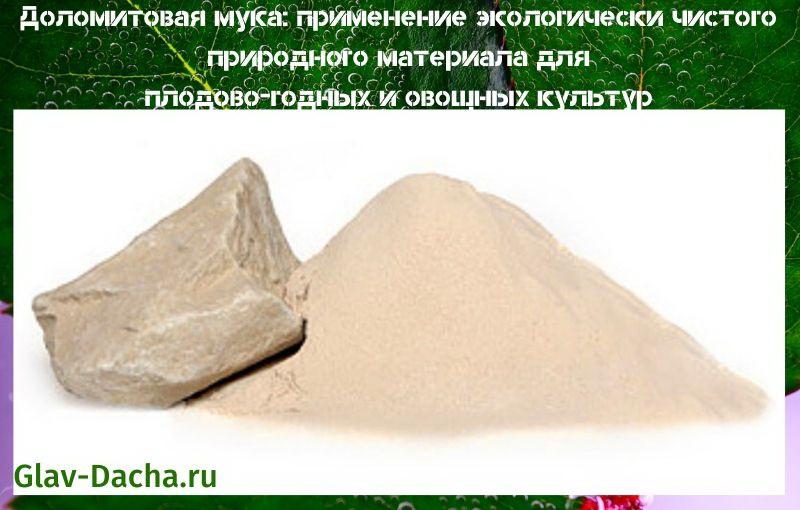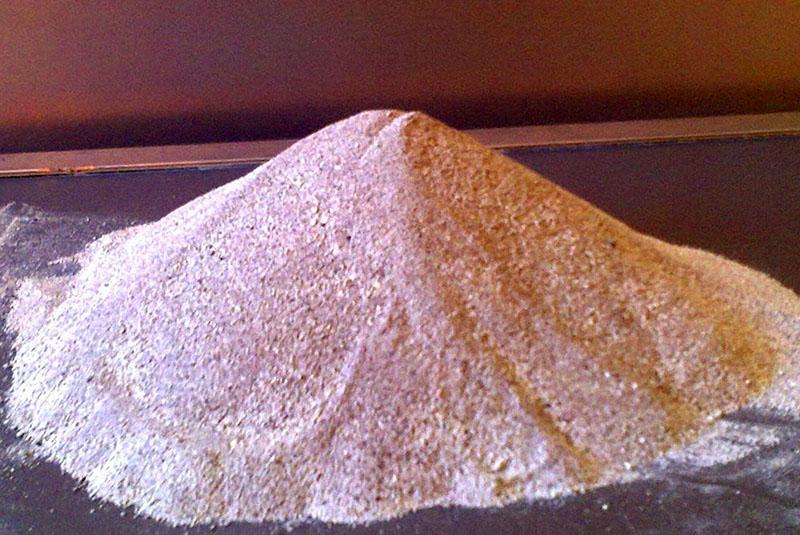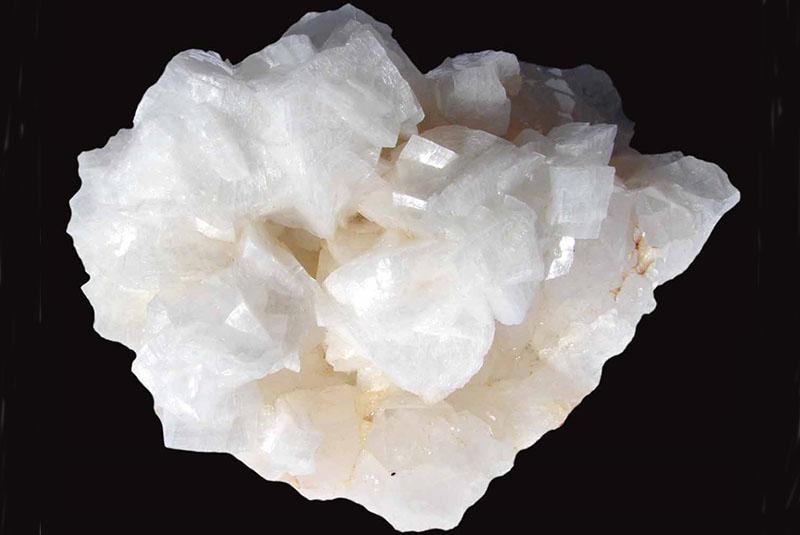Dolomite flour: the use of environmentally friendly natural material for fruit and vegetable crops
 Gardeners and gardeners know that most vegetable, berry and fruit crops prefer alkaline, neutral soil, and in acidic soils they grow slowly, and are more susceptible to disease due to weakened immunity. To solve the problems of acidification of the planting soil, dolomite flour is used, the use of which improves the quality characteristics of the planting soil.
Gardeners and gardeners know that most vegetable, berry and fruit crops prefer alkaline, neutral soil, and in acidic soils they grow slowly, and are more susceptible to disease due to weakened immunity. To solve the problems of acidification of the planting soil, dolomite flour is used, the use of which improves the quality characteristics of the planting soil.
Description of dolomite flour

The beneficial properties of a substance are due to its composition. Quicklime lime is a natural soil deoxidizer, helps to strengthen plant roots. Burnt magnesia affects the process of photosynthesis, nourishes the green mass, and increases productivity. The rest of the trace elements stimulate plants at all stages of growth and development.
Pros of a natural deoxidizer
 The main reason why dolomite powder is used in the garden is the alkalization of the soil. At the same time, the mineral makes the soil softer and looser. In addition, dolomite belongs to environmentally friendly natural fertilizers, so it is safe for plants and humans. Dolomite has many advantages.
The main reason why dolomite powder is used in the garden is the alkalization of the soil. At the same time, the mineral makes the soil softer and looser. In addition, dolomite belongs to environmentally friendly natural fertilizers, so it is safe for plants and humans. Dolomite has many advantages.
Soft impact on the soil
Dolomite flour is a softer soil deoxidizer in comparison with lime. It can be applied all year round, at any time during the life of vegetable crops. The powder does not burn the roots and tops, unlike quicklime, which can only be applied in autumn so as not to harm the plants.
Profitability
Compared to ash and lime (known soil alkalizing agents), dolomite flour needs to be added 2 times less to achieve a similar result.
Effectiveness against pests and diseases
Dolomite powder is great for slugs, wireworm, other pests with soft chitinous integuments. It works as an abrasive substance, destroying the outer shell of the insect's body, which leads to its death. In the summer against pests, plant leaves are pollinated with dolomite flour for prevention and treatment. Helps the powder in the fight against infectious soil diseases (scab, cabbage keel). And at the same time stimulates earthworms to work.
Versatility
The use of dolomite in the country, in the garden not only alkalizes the soil, but additionally increases the amount of hydrogen ions in the substrate, raises the level of calcium, and replenishes the amount of trace elements necessary for plants even on neutral soils.
An improvement in the internal soil structure is observed (the development of beneficial microorganisms in it, saturation of the upper layers with potassium, phosphorus, nitrogen). Dolomite application to soil reduces weeds
The powder binds radionuclides, salts of heavy metals, toxins in the soil, preventing harmful impurities from penetrating the fruits.It enriches the soil with magnesium and calcium, due to which full-fledged root formation is ensured, metabolic processes and photosynthesis are accelerated.
Improved flowering and yield
 Thanks to the use of dolomite flour, the flowering of vegetable and fruit crops is prolonged. They develop healthy, luscious foliage due to the large amount of magnesium, which contributes to the production of chlorophyll necessary for photosynthesis. In addition to building up green mass, dolomite flour promotes the formation and ripening of fruits. Due to the large amount of calcium and magnesium in natural dressing, the ripening of fruits is accelerated, and their taste improves.
Thanks to the use of dolomite flour, the flowering of vegetable and fruit crops is prolonged. They develop healthy, luscious foliage due to the large amount of magnesium, which contributes to the production of chlorophyll necessary for photosynthesis. In addition to building up green mass, dolomite flour promotes the formation and ripening of fruits. Due to the large amount of calcium and magnesium in natural dressing, the ripening of fruits is accelerated, and their taste improves.
Dolomite increases the yield of many crops. Beets, potatoes, garlic, carrots, onions, cabbage, eggplants are sensitive to it. The potatoes become more starchy, the tubers do not get scab. Sprinkling flour on the foliage reduces the amount of Colorado potato beetle.
Dolomite's main advantage is its unique chemical formula. The composition contains a complex of magnesium and calcium, while most dressings contain only calcium. It contains 40% magnesium and 48% calcium. This balance is good for the development and growth of cultures. After the correct application of dolomite flour for 2-3 years, an increase in yield is observed by an average of 15%.
Quantity calculation
 Dolomite flour can be purchased at gardening stores. The best powder is considered to be a fine fraction, the grains of which interact faster with the substrate.
Dolomite flour can be purchased at gardening stores. The best powder is considered to be a fine fraction, the grains of which interact faster with the substrate.
Before adding dolomite, it is necessary to determine the acidity of the soil. This is done in different ways. Special testers, litmus tests, folk remedies (vinegar, soda, grape juice).
Depending on the acidity, the amount of dolomite flour is calculated. The figures are shown in the table:
| Soil pH level. | The amount of deoxidizer per square meter of soil. |
| 4.5 or less. | 600 gr. |
| 4,6-5,2. | 450 gr. |
| 5,2 – 5,6. | 350 gr. |
For alkalization, dolomite flour is applied every five years. The highest effect appears at 2 or 3 years.
It is not recommended to add dolomite to the soil with neutral and alkaline pH. Fertilizing increases the amount of calcium, which can lead to lower yields.
The amount of dolomite powder depends on the density of the soil. For heavy soils, the amount of fertilizer is increased by 20%. For loose, lungs, the volume is reduced by 1.5 times. Heavy soil is fertilized annually, light once every 3 years.
When dolomite is introduced into closed ground, its amount is reduced to 100 grams per square of soil and left on the surface, since the ground is protected from wind and rain. This method simultaneously deacidifies the soil, mulches it, and fills it with magnesium and calcium. The thinnest layer of flour forms a film on the surface, preventing the liquid from evaporating from the soil.
Dolomite flour application by seasons (rules and subtleties)
 The best period for adding dolomite is spring, when open and closed beds are being prepared for planting. In order to improve the quality of the soil, protect it from fungus, mold, and rot, it is better to introduce flour in April and May.
The best period for adding dolomite is spring, when open and closed beds are being prepared for planting. In order to improve the quality of the soil, protect it from fungus, mold, and rot, it is better to introduce flour in April and May.
Treatment for the purpose of alkalization is carried out every 6-10 years. Flour is evenly sprayed over the ground, leveled with a rake, dug up the ground to a depth of at least 10 cm. Digging is necessary to accelerate the action of dolomite. If it is not carried out, you will have to wait for a heavy rain so that with its help the powder penetrates into the ground. But this is not rational. If there is no rain, in windy weather the light powder will quickly sweep away from the site.
In summer, the use of dolomite flour for alkalizing the soil is not practiced.
It is used for fertilization so that healthy foliage forms faster in fruit, berry and vegetable crops, and fruits are tied. It is enough to add dolomite once a month or one and a half. To improve vegetation at the very beginning of summer, you can use a liquid dressing in the form of a weak aqueous solution. One part of the flour is diluted with 10 parts of water.The resulting top dressing is used for open and closed ground.
In the autumn, dolomite powder is used to fertilize berry-fruit bushes and trees.
To reduce the acidity of the soil, its use is impractical, since it begins to exert its beneficial effect when it penetrates into the deep layers of the soil, which is facilitated by the melting of the snow cover.
In August-September, after harvesting the fruits, flour is scattered over the diameter of the root system. For trees it is 2 meters, for bushes - 1 meter. Then the soil is carefully loosened. On average, one plant takes 0.5 - 2 kg of dolomite flour (500 grams per bush, 1.5 kg per tree). Top dressing is applied once a year, bone meal can be added. Dolomite flour is used in the garden in the fall to restore the viability of neglected areas, improve their fertility, use the method of complex alkalization. Before the autumn digging, phosphate rock is added, and in the spring, dolomite powder.
Features of using dolomite
 Dolomite flour is combined with copper sulfate and boric acid. These substances enhance each other's effectiveness. It is recommended to add 8 ml of boric acid or half a teaspoon of vitriol per kilogram of dolomite powder to enhance the effect of flour against fungal infections of root crops.
Dolomite flour is combined with copper sulfate and boric acid. These substances enhance each other's effectiveness. It is recommended to add 8 ml of boric acid or half a teaspoon of vitriol per kilogram of dolomite powder to enhance the effect of flour against fungal infections of root crops.
But it should not be combined with ammonium sulfate, urea, ammonium nitrate, superphosphate, compost and manure. They neutralize the action of each other, there is practically no benefit from their simultaneous use. Therefore, between the introduction of dolomite and fertilizers incompatible with it, there should be a time interval of 7-14 days.
Limestone flour is used in the garden to treat insect-infested crops. They sprinkle the tops with it. For the purpose of deoxidation and fertilization, the powder is applied when sowing or transplanting plants. Dolomite is poured into the holes or grooves, and over time it spreads along the diameter of the root system. The exception is tomatoes, strawberries, potatoes, for which dolomite must be introduced in advance in the spring with digging of the site.
Dolomite flour is not used for crops that prefer moderately acidic soil (blueberries, gooseberries, cranberries, blueberries).
Each plant prefers a specific soil pH. Strong acidity leads to the fact that the root system of most of them cannot absorb the necessary minerals from the earth. Dolomite flour solves the problem, the use of which allows plants to receive comprehensive care. As a result, after a couple of years, the yield increases by 15%.